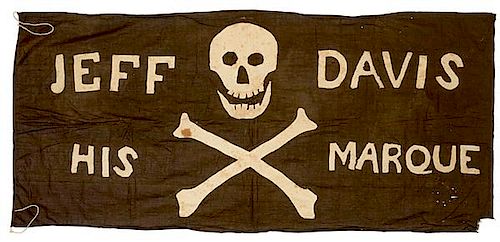Exceptionally Rare Jeff Davis His Marque Civil War Flag of Capt. H.P. Kile, 41st OVI
About Seller
6270 Este Ave.
Cincinnati , OH 45232
United States
With offices in Cincinnati, Cleveland and Denver, Cowan’s holds over 40 auctions each year, with annual sales exceeding $16M. We reach buyers around the globe, and take pride in our reputation for integrity, customer service and great results. A full-service house, Cowan’s Auctions specializes in Am...Read more
Two ways to bid:
- Leave a max absentee bid and the platform will bid on your behalf up to your maximum bid during the live auction.
- Bid live during the auction and your bids will be submitted real-time to the auctioneer.
Bid Increments
| Price | Bid Increment |
|---|---|
| $0 | $25 |
| $500 | $50 |
| $1,000 | $100 |
| $2,000 | $250 |
| $5,000 | $500 |
| $10,000 | $1,000 |
| $20,000 | $2,500 |
| $50,000 | $5,000 |
| $100,000 | $10,000 |
About Auction
Nov 4, 2015 - Nov 7, 2015
Cowan's Auctions dawnie@cowans.com
- Lot Description
Exceptionally Rare Jeff Davis His Marque Civil War Flag of Capt. H.P. Kile, 41st OVI
A double-sided flag constructed of polished black cotton, 23" at the hoist, and 53" on the fly, with a hand-sewn sleeve and cotton cord for attaching to a pole, displaying hand-cut and hand-sewn white muslin lettering on both sides, reading Jeff Davis and His Marque (below) flanking skull and crossbones insignia.
Along with Lot 666, this flag descended in the family of Captain Horatio P. Kile, of Companies G and H of the 41st Ohio Volunteer Infantry. A resident of Geauga County, Kile enlisted on September 10, 1861 for a three year hitch, mustering into service as a 2nd Lieutenant assigned to Company G. He was promoted to 1st Lieutenant on January 1, 1862 and became Captain and was transferred to Co. H on March 24, 1863.
Under the overall command of West Point Graduate Colonel Robert Hazen, the 41st developed a reputation as a hard-fighting, spit and polish Western Theater unit. During the course of the War the unit suffered 174 KIAs and 156 DOD’s. The 41st took an active part in virtually every important engagement in the West, including Shiloh, Corinth, Perryville, Murfreesboro, the Tullahoma Campaign, Chickamaga, Brown’s Ferry, Lookout Mountain, and the relief of Nashville.
In his three years' service, Kile was with the unit throughout, missing only the action at Shiloh. He was promoted to 1st Lieutenant on Jan. 1, 1862 and became Captain of Co. H on March 24, 1863. Kile was wounded at Missionary Ridge, Nov. 25, 1863 and was mustered out of the army on Nov. 10, 1864 at Pulaski, Tennessee.
The use of this flag is unknown. It is not mentioned in the regimental history of the 41st (see Stevens' "Ohio in the Civil War" or the Official Records of the War ("OR's"). That it was meant to be flown is certain; the flag retains a sleeved hoist containing a medium weight cotton rope. As an "unofficial" flag, it might have been employed by either of the companies with which Kile was associated during the war, and could have served as a camp flag, identifying company headquarters.
It is also possible that the flag was taken by Kile from the Confederate camps at Corinth during the third week of May, 1862. As noted in the description for Lot 666, Kile collected several "souvenirs" at Corinth, including a smoking jacket, and possible CS artillery kepi. If the flag was a Confederate color, it was unofficial, and carried a message that is today obscured by time.
More than likely the flag was a northern symbol, with the message carried by the skull and cross bones and "Jeff Davis His Marque" known to every Northerner. Nearly identical symbols were used on a number of different types of Northern Patriotic envelopes that are connected to a national response against Jefferson Davis’ letters of marque issued early in the war which granted private citizens and other nations the right to capture or confiscate Northern merchant ships.
In a confrontational article entitled “The Pirate Flag,” in April 1861, The New York Times, decrying the issue of letters of marque by the Confederate states, wrote, “Mr. JEFFERSON DAVIS…has hung out the true flag of the Confederates…” The “true flag” was the Jolly Roger, the pirate brand.
By the outbreak of the Civil War seizure of commercial ships by privateers had been outlawed by international treaty by all of the world's great powers. Davis, recognizing that the Confederate Navy was non-existent, hoped to enlist private citizens by issuing letters of marque to allow plundering of Union commercial vessels. The northern press branded Davis a pirate who condoned “the habits and practices of the barbarism of a hundred years ago” and “JEFFERSON DAVIS might as well have thrown a lighted match into a powder magazine,” wrote the Times. “The effect of his proclamation upon our community has been only to deepen and make tenfold more intense the hatred and indignation of the public… There is but one way of dealing with such people. We are to measure our strength with theirs, -- and may GOD defend the right!”
A fine and unique Civil War flag.
Reference:
"The Pirate Flag," The New York Times, April 20, 1861, accessed September 8, 2015. http://www.nytimes.com/1861/04/20/news/the-pirate-flag.htmlFlag is in generally fine condition, though the black cloth has faded to a uniformly dark brown. Several of the letters exhibit light foxing. One corner of the leading edge of the fly appears to have been "souvenired."Condition
- Shipping Info
-
SHIPPING. At the request of the buyer, Cowan's will authorize the shipment of purchased items. Shipments usually occur within two weeks after payment has been received. Shipment is generally made via UPS Ground service. Unless buyer gives special instructions, the shipping method shall be at the sole discretion of Cowan's Auctions, Inc.. Cowan's is in no way responsible for the acts or omissions of independent handlers, packers or shippers of purchased items or for any loss, damage or delay from the packing or shipping of any property.
-
- Buyer's Premium



 EUR
EUR CAD
CAD AUD
AUD GBP
GBP MXN
MXN HKD
HKD CNY
CNY MYR
MYR SEK
SEK SGD
SGD CHF
CHF THB
THB















